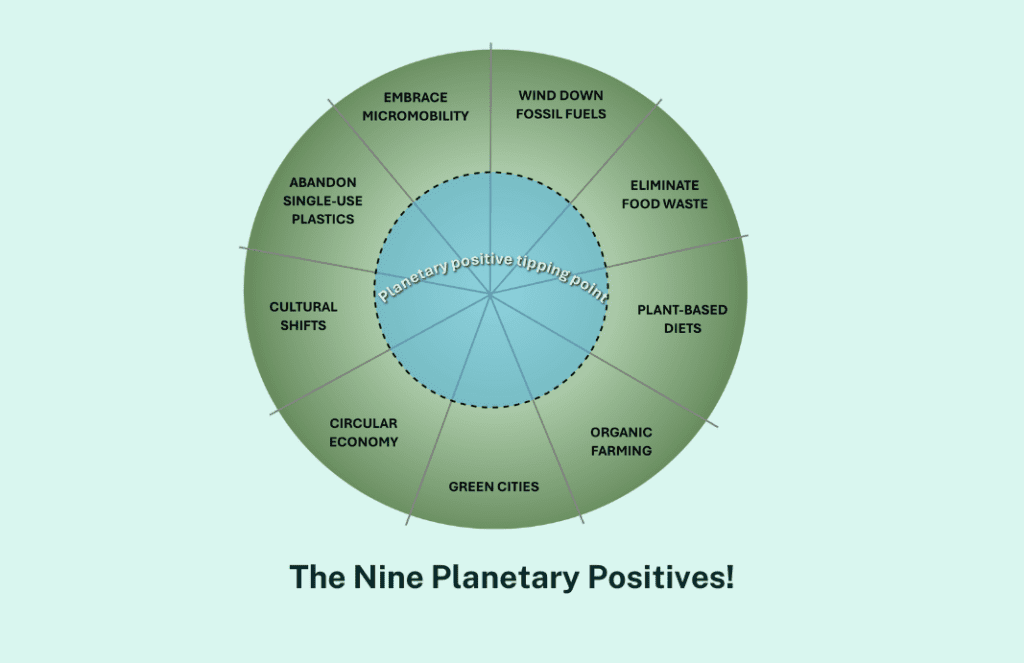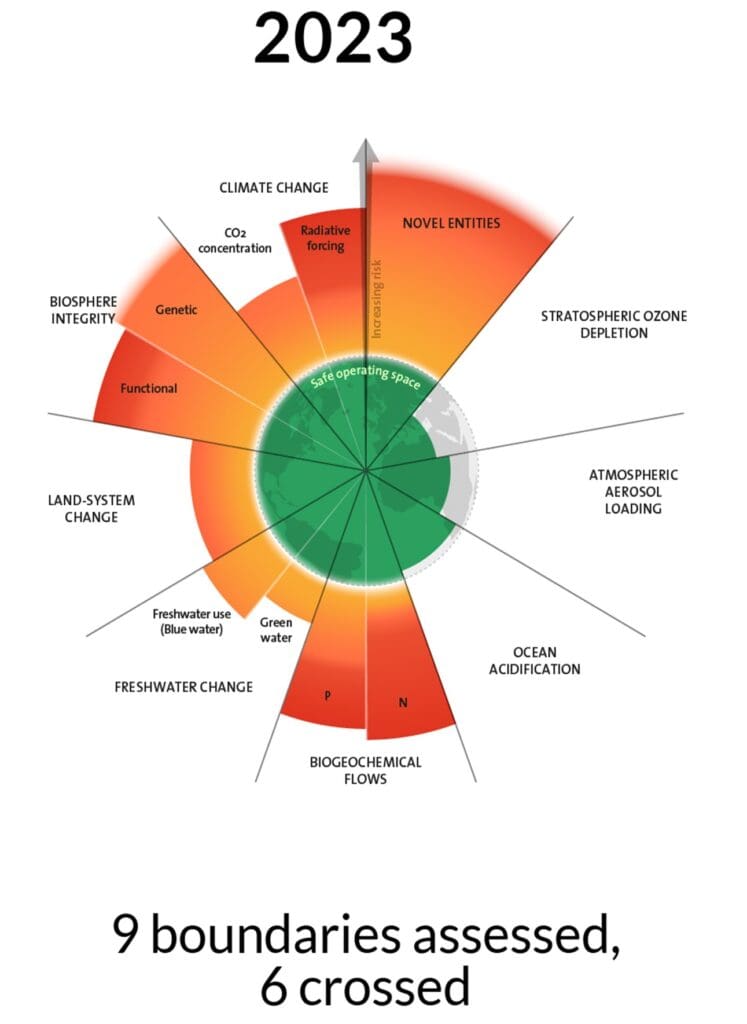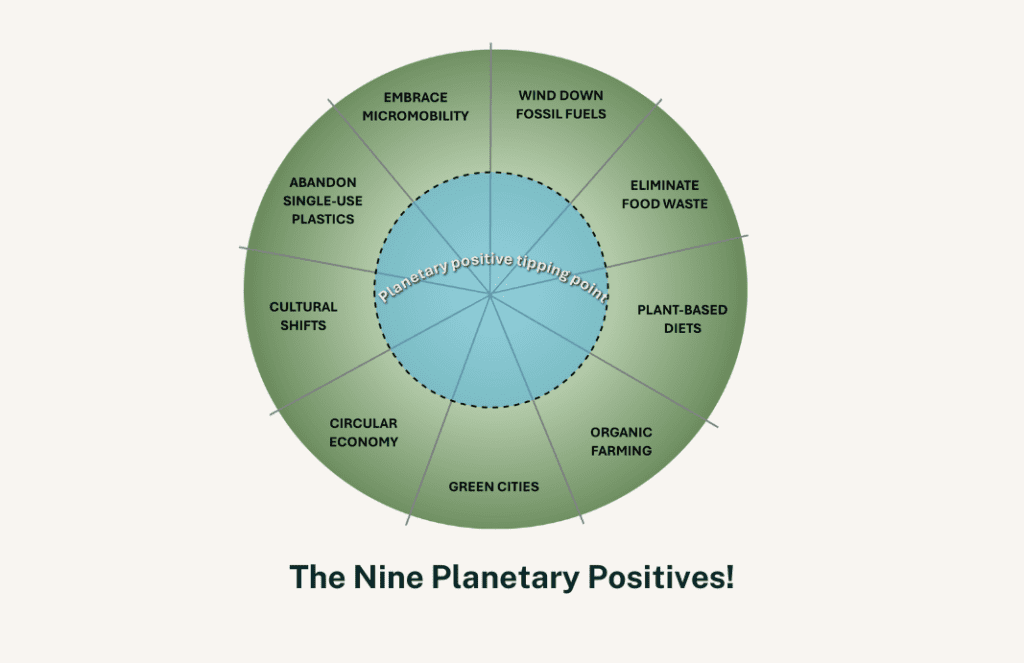The Nine Planetary Positives!
In 2009, Johan Rockström, the former director of the Stockholm Resilience Centre (part of Stockholm University) and his colleagues proposed that there are nine planetary boundaries within which humanity can safely continue to develop and thrive for generations to come.

These boundaries refer to processes which regulate the stability and resilience of certain Earth systems. Crossing boundaries increases the risk of generating large-scale abrupt or irreversible environmental changes, with severe implications for humans on planet Earth. As of 2023, the team believes that six of these nine boundaries have been crossed, pushing the planet into a dangerous space for long-term human habitation.

The Nine Planetary Boundaries – Stockholm Resilience Centre, 2024
The model is compelling and concerning. But it also got me thinking. Could it be flipped on its head?
Instead of negative tipping points, what if we could identify and work towards nine planetary positives – actions that would help address the current overshoot on the planetary boundaries, whilst also triggering other positive tipping points to help ensure that humanity can continue to develop and thrive for generations to come.
Here are a few brief thoughts on just nine such steps.

1. Winding down our reliance on fossil fuels
According to the International Energy Agency (IEA), in 2023 the world consumed around 8.5 billion tonnes of coal[1]. We also consumed 102.3 million barrels of oil a day (approximately 16 billion litres) [2] and burned approximately 4,000 billion cubic meters of natural gas.[3]
Putting to one side the carbon cost of burning these fuels at the point of consumption,[4] the production, transport and processing of just oil and gas resulted in 5.1 billion tonnes of CO2 equivalent (CO2eq) gasses in 2022, or just under 15% of total energy-related greenhouse gas (GHG) emissions.[5]
In addition to the obvious benefits to several of the planetary boundaries of eliminating this 5.1 billion tonnes of CO2eq from our overall global emissions, winding down our reliance on oil and gas offers a host of other positive impacts:
• In 2021, energy products accounted for 36% of global shipping.[6] Shipping, itself, accounts for around 3% of global emissions, so by winding down our reliance on fossil fuels we can also reduce the global need for shipping by around a third.
• The World Bank estimates that the annual global cost of health damages associated with exposure to air pollution is approximately $8.1 trillion.[7] Phasing out fossil fuels is the most important thing we can do to reduce air pollution and reduce this extraordinary cost to the global economy, and – more importantly – human health.
• Oil spills have a devastating impact on marine ecosystems and biodiversity. There are thousands of oil spills every year, just in US waters.[8] Less oil = less oil spills.
None of this is to ignore the carbon cost and other environmental impacts of deploying the wind, solar, battery and other solutions that we will require as part of the energy transition. But it is undeniably the case that transitioning away from fossil fuels would be a major planetary positive.
2. Eliminating food waste
According to the United Nations, a fifth of food is thrown away. In 2022, it is estimated that 1.05 billion tonnes of food went to waste. That waste accounts for approximately 10% of global GHG emissions.[9]
A 2023 report by the UN Food and Agriculture Organization[10] estimated that in 2022:
• between 690 and 783 million people in the world faced hunger;
• 4 billion people, comprising relatively more women and people living in rural areas, did not have access to nutritious, safe and sufficient food all year round;
• global hunger, measured by the prevalence of undernourishment, affected around 9.2% of the global population.
It is widely accepted that, today, farmers produce enough food for around 10 billion people (the current global population is just over 8 billion). In addition to an astonishing 10% reduction in global GHG emissions, eliminating food waste would offer a host of further planetary positives by ensuring that everyone, everywhere, had access to a sufficiently nutritious diet of high-quality calories, reducing the need for involuntary migration driven by food insecurity, and inevitably supporting the global economy through immense increases in global productivity and reduced healthcare costs.
3. Global shift towards a plant-based diet
When it comes to tackling climate change, one of the most effective and immediately impactful things that an individual can do is shift towards a plant-based diet.
It is hard to overstate the impact on climate change, land use and the global stability of fresh water supplies (three of the planetary boundaries) that animal agriculture has. A few facts are useful to inform the discussion.
• There are about 940 million cattle in the world at any given moment. About 900,000 are slaughtered every day for meat.[11] [12]
• About 5 billion hectares, or 38% of the earth’s global land surface, is used for agriculture. About one-third of this is used for growing crops. The remaining two-thirds is used for grazing, or growing crops for livestock. About one-third of all the freshwater used annually is used for raising livestock or growing crops to feed livestock.[13]
• Manure from cattle releases nitrous oxide. Cattle also burp methane. Over 100 years, nitrous oxide and methane have, respectively, around 300 times and 28 times more impact as greenhouse gasses, than carbon dioxide. Animal agriculture is responsible for approximately 65% of anthropogenic nitrous oxide emissions and 37% of anthropogenic methane emissions.[14]
• Beef production is responsible for approximately 41% of global deforestation, as land is cleared to make space for cattle ranching, grazing, or growing feed crops.[15]
Depending upon what you include in the calculation, agriculture is responsible for about 19% of global GHG emissions, the majority of which come from animal agriculture. A global shift towards a more plant based diet is a critical part of our global efforts to stop climate change.
There is another significant win potentially available here. Research suggests that if we could use better farming techniques to store just 1% more carbon per year in about half the world’s agricultural soils, this would be enough to absorb about 31 gigatonnes of carbon dioxide annually – a huge contribution to reaching net zero.[16] If a shift towards plant-based diets were to materially reduce the amount of land required to rear and feed cattle, we could unlock vast spaces that could be dedicated entirely to carbon capture through improved soils. This would bring a host of associated biodiversity and other benefits also, by returning this land to nature.
A true planetary positive in every sense.
4. Adopting organic farming
Imbalances in biogeochemical flows of nitrogen and phosphorous are two planetary boundaries (counted together for the purpose of that model) which have been substantively breached. Both could be at least partially addressed through a global shift towards organic farming, which means a significant reduction in global use of fertilizers, pesticides and herbicides.
According to the International Fertilizer Association, we used 192.5 million tonnes of fertilizers worldwide in 2023.[17] Research in 2023 from the University of Cambridge has suggested that, once the full lifecycle of these products is taken into account, manure and synthetic fertilisers emit the equivalent of 2.6 gigatonnes of carbon per year – more than global aviation and shipping combined.[18]
The broader planetary positives of abandoning the use of these chemicals and shifting towards organic farming include:
• Health – According to Pesticide Atlas, about 385 million cases of pesticide poisoning occur worldwide every year. People in the Global South working in rural areas are particularly affected.[19]
• Biodiversity – Intensive agriculture with pesticides and fertilizers are believed to account for some 46% of the decline in global insect populations.[20]
• Water – Every year the world uses approximately 3 million tonnes of agricultural pesticides and herbicides. A 2023 global study by the University of Sydney found that approximately 70,000 tonnes of potentially harmful chemicals leach into aquifers each year, impacting ecosystems and freshwater resources. [21]
5. Greening our cities
The concept of ‘greening’ cities can be controversial. Many argue that by their very nature cities cannot be environmentally friendly or sustainable places, with so many people living in such close proximity, consuming huge amounts of fresh water and producing vast quantities of waste.
Whatever the realities of that debate, urbanisation shows no sign of slowing down – according to the World Bank about 56% of the world’s population lives in cities. This figure is expected to increase to around 70% by 2050.[22] As the planet continues to warm, demand for air conditioning is expected to increase; demand for cooling is projected to be the second‐largest contributor to the overall rise in global electricity demand over the coming decades, behind electric vehicles.[23] This challenge is compounded by the ‘urban heat island effect’ (UHIE), a phenomenon of cities which can cause them to be several degrees hotter than surrounding rural areas.
‘Greening’ our cities, in this context, involves incorporating by design (and re-incorporating into existing city infrastructure), as much green space and plant cover as possible, including on rooftops, balconies, by way of parks, and as part of the design and construction of new buildings themselves. By expanding tree cover and other vegetation in cities, we can use the power of nature to help mitigate the UHIE, as plants provide shade, reflect heat and release moisture into the atmosphere,[24] all of which can make a significant contribution to reducing our demand for energy for cooling.
Greening our cities in this way can also help combat flooding, promote biodiversity, sequester carbon dioxide, help harvest rainwater, and even contribute to promoting social equality, as research shows that ethnic minorities are often priced out of green areas of cities where property prices tend to be higher.[25]
6. Embracing the circular economy
The concept of the circular economy is growing rapidly amongst those engaged in the climate change space. The circular economy is about shifting our thinking away from traditional notions of how economies operate and goods are produced, towards a more sustainable model.
According to the Ellen MacArthur Foundation:
“The circular economy is a system where materials never become waste and nature is regenerated. In a circular economy, products and materials are kept in circulation through processes like maintenance, reuse, refurbishment, remanufacture, recycling, and composting.”[26]
A circular economy would help us to address our current overshoot of many of the planetary boundaries.[27] It can help us reduce pollution and the volume of waste being sent to landfill. It can help us reduce our use of freshwater and toxic chemicals. It can help us to support nature and biodiversity by reducing the amount of land from which we are extracting resources.
Embracing a truly circular economy would be a powerful planetary positive.
7. Cultural shift away from mass consumerism
Parts of our economy, particularly in spaces like fast fashion and consumer electronics, rely upon a culture of mass consumerism. We are encouraged to purchase far more than we need in order to always have the latest fashion or gadget, often using items only a handful of times before they are relegated to a cupboard and eventually discarded to landfill to make space for the next purchase.
We don’t tend to think of these behaviours as having negative impacts on the planet and environment, often because those of us engaged in this kind of consumption do not see the harms that our behaviours cause.
The fashion industry is a particularly powerful case study on this topic.
It is estimated that, globally, we produce up to 150 billion items of clothing each year.[28] The fashion industry is estimated to be responsible for 10% of global carbon emissions. Because cotton is a highly water-intensive crop, it takes about 700 gallons of water to produce a cotton shirt, or 2,000 gallons of water to produce one pair of jeans. The fashion industry is believed to be responsible for 20% of all industrial water pollution worldwide, and dying processes use enough water to fill two million Olympic-sized swimming pools every year.[29]
By changing certain cultural norms and shifting our mentality away from one of mass consumerism, we can significantly reduce our extractive and polluting impact on the planet, thereby addressing many of the planetary boundaries.
8. Abandon single-use plastics
The impact of single-use plastics on the health of our planet is hard to overstate.
According to the UN, “plastic waste can take anywhere from 20 to 500 years to decompose, and even then, it never fully disappears; it just gets smaller and smaller.”[30]
The OECD estimates that only 9% of plastic is recycled.[31] Discarded plastic might be out of sight, but it is not out of existence. That which is not recycled goes to landfill, failing which it often ends up in rivers, and ultimately the ocean, causing pollution and having critical impacts on biodiversity and ocean health. Our reliance on single-use plastics is a critical part of this problem, the vast majority of which is generated by the food and drinks industry.
The good news here is that work is ongoing towards a UN-backed Global Plastics Treaty to start to address parts of this problem. By significantly reducing our reliance on single-use plastics we can address several of the planetary boundaries, promoting the health of our oceans and soils and reducing pollution in key ecosystems around the world.
9. Embracing micromobility
There were over 280 million electric mopeds, scooters, motorcycles and three-wheelers on the roads in 2022. According to estimates by Bloomberg, these vehicles (collectively known as electric micromobility) are already reducing global demand for oil by about a million barrels of oil a day.[32] Researchers in the US suggest that if the percentage of urban journeys made by e-bikes rises to 11%, we could see a 7% decrease in CO2 emissions from the urban transport sector by 2030, equivalent to taking 134 million cars off the road.
Electric micromobility is booming, particularly in China and India where these forms of transport are immensely popular. This growth is happening all around the world. In Australia, for example, more than 100,000 electric bicycles were sold in 2022. And in Paris, cycling has now surpassed driving as a preferred method for getting around the city centre.[33]
Reports suggest that 44% of all commutes in Australia are made by car and cover a distance of less than 10km. In Perth, for example, of the 4.2 million daily car trips, 2.8 million are less than 2km. Use of cars for these kinds of short journeys is common in wealthier countries; in the US it is estimated that 60% of all car trips cover less than 10km.
Electric micromobility has huge potential to replace cars for journeys of this type. This would be a planetary positive across the board, saving people money, reducing emissions and the volume of materials required for manufacturing in the transport sector, and making public transport more accessible to people who would otherwise need to use a car to reach it.
Conclusion
In February 2024, Johan Rockström was awarded the Tyler Prize (often called the environmental Nobel Prize) for his work on the nine planetary boundaries. Reflecting on the latest edition of the model, Mr Rockström said:
“This update on planetary boundaries clearly depicts a patient that is unwell, as pressure on the planet increases and vital boundaries are being breached. We don’t know how long we can keep transgressing these key boundaries before combined pressures lead to irreversible change and harm.”[34]
The planetary boundaries should act as an urgent wake-up call for all of us. Individually they put us in a dangerous space; collectively they risk combining into an unmanageable threat.
The good news here is that we are not powerless to change course, and there any many steps that we can take, both as a society and individually in our daily lives, which have positive impacts across the board.
The nine so-called planetary positives presented in this article are intended as little more than a starting point. But they do demonstrate that we can all make a difference. So let’s get to work. And make sure that through our positive actions, humanity can continue to develop and thrive on a positive planet Earth, for generations to come.

…
You can learn more about the nine planetary boundaries model here: Planetary boundaries – Stockholm Resilience Centre
[1] https://www.iea.org/reports/coal-2023/demand
[2] Report – IEA – Oil 2023
[3] https://www.iea.org/energy-system/fossil-fuels/natural-gas
[4] According to the IEA, burning the various fuels produced from an average barrel of oil generates 405kg of CO2. Burning one cubic meter of natural gas releases approximately 1.9kg of CO2.
[5] Report – IEA – Emissions from Oil and Gas Operations in Net Zero Transitions – June 2023
[6] Shipping’s Role in the Global Energy Transition | International Chamber of Shipping (ics-shipping.org)
[7] Taking action for the health of people and the planet | United Nations
[8] Oil spills | National Oceanic and Atmospheric Administration (noaa.gov)
[9] With 783 million people going hungry, a fifth of all food goes to waste | UN News
[10] Report – UN FAO – The State of Food Security and Nutrition in the World 2023
[11] Cattle/cow population worldwide 2012-2023 | Statista
[12] How many animals get slaughtered every day? – Our World in Data
[13] Book – “We are the weather” – Jonathan Safran Foer
[14] Ibid
[15] Cutting down forests: what are the drivers of deforestation? – Our World in Data
[16] Improving soil could keep world within 1.5C heating target, research suggests | Farming | The Guardian
[17] Global Nitrogen Fertilizer Supply, Demand Outlook Generally Favorable (dtnpf.com)
[18] Article – ‘Greenhouse gas emissions from nitrogen fertilisers could be reduce by up to one-fifth of current levels by 2050 with combined interventions.’ – Yunhu Gao and André Cabrera Serrenho – Nature Food (2023)
[19] Publication – Pesticide Atlas 2022
[20] Ibid.
[21] Global analysis shows how pesticides leach into the environment – The University of Sydney
[22] Urban Development Overview (worldbank.org)
[23] Report – IEA – Sustainable, Affordable Cooling Can Save Tens of Thousands of Lives Each Year – 2023
[24] Reduce Urban Heat Island Effect | US EPA
[25] Green spaces keep cities cooler and fairer, WRI says | World Economic Forum (weforum.org)
[26] What is a circular economy? | Ellen MacArthur Foundation
[27] The Circularity Gap Report 2023 – Circle Economy and Deloitte
[28] Why Are Billions Of Clothes Never Even Sold? | British Vogue
[29] Is fashion bad for the environment? | World Economic Forum (weforum.org)
[30] In Images: Plastic is Forever | United Nations
[31] Plastic pollution is growing relentlessly as waste management and recycling fall short, says OECD
[32] The world’s 280 million electric bikes and mopeds are cutting demand for oil far more than electric cars (theconversation.com)
[33] Cycling is now more popular than driving in the centre of Paris, study finds | Euronews
[34] All planetary boundaries mapped out for the first time, six of nine crossed – Stockholm Resilience Centre
Get in touch
We opened our doors on 4 March 2024. As a relatively new firm, we are not yet in a position to offer all of the services described on this website. We have done our best to make clear what we can do now, and what forms part of our exciting plans for the years ahead. We are working hard to make our ambitious vision into a reality.
In the meantime, please do subscribe to receive our regular thought leadership and feel free to follow our journey and progress on LinkedIn.
